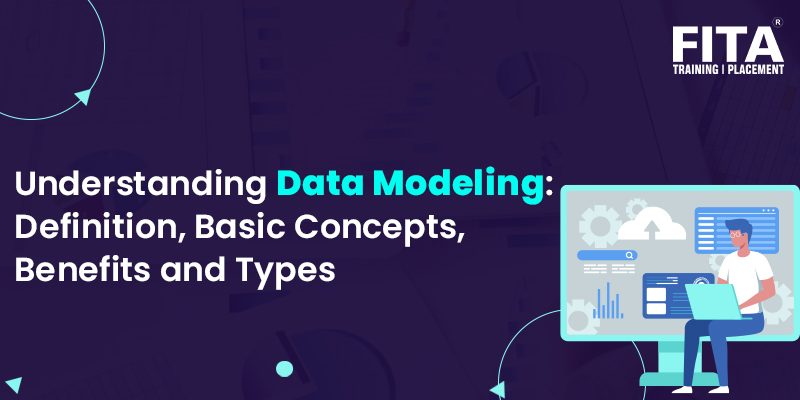
Information is transforming how things work in the world. It can involve studying disease treatments, a company’s plan to make money, making buildings more effective, or those ads you see on your social media; all of this is because of information.
This information refers to data that machines can understand, not just people. For instance, if customer data doesn’t show what products they bought, a product team won’t find it useful. Similarly, a marketing team won’t find that same data helpful if it doesn’t connect to the prices customers pay.
That’s where Data Modeling comes in. It’s the process of organising data in a way that makes sense. A Data Model simplifies data into useful information that organisations can use to make decisions and plans. According to LinkedIn, it’s the job that’s growing the fastest in the job market right now. Enhance your skills in understanding and utilizing data models by enrolling in Data Analytics Course in Chennai. Before we dive into what data modelling is, let’s first understand what a Data Model really means.
What is a Data Model?
Effective data enables organizations to establish starting points, standards, and objectives to keep progressing. For data to facilitate this assessment, it needs to be organized through data description, data meaning, and ensuring data consistency. A Data Model serves as an abstract representation that enables the development of conceptual models and helps establish connections between data elements.
An organisation might possess extensive data collection. However, if there’s no standard to ensure the fundamental accuracy and understandability of that data, then it becomes useless. A proper data model ensures achievable outcomes from the data, awareness of the most effective methods regarding the data, and the most suitable tools for accessing it.
What is Data Modeling?
In software engineering, Data Modeling refers to simplifying the diagram or data model of a software system using specific formal techniques. It involves representing data and information using text and symbols. The data model serves as a plan for constructing a new database or updating older applications.
Considering the information above, it is the crucial initial step in defining the structure of existing data. Data Modeling involves creating data models that describe data connections and limitations, which are then translated into code for reuse. It visually represents data with diagrams, symbols, or text to illustrate the relationships between them.
Data Modeling contributes to enhancing consistency in naming, rules, meaning, and security. As a result, it improves data analysis. The focus is on ensuring the accessibility and organisation of data, regardless of how it’s used.
Data Modeling Process
Data modelling involves creating an abstract illustration of data elements and how they relate to each other. This process generally includes steps such as gathering requirements, conceptualising, designing logically, designing physically, and implementing. Throughout each stage, data modellers collaborate with stakeholders to comprehend data needs, define entities and characteristics, establish connections between data components, and construct a model that precisely reflects the data in a manner usable by application developers, database administrators, and other involved parties, a critical skill for individuals pursuing Data Science Training in Pune.
Levels Of Data Abstraction
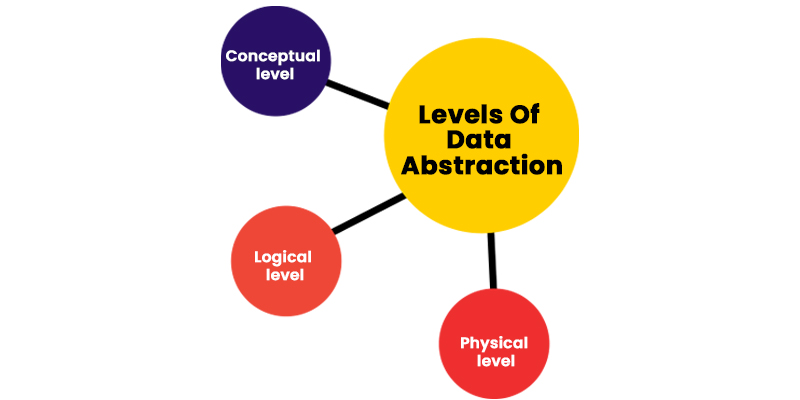
Data modeling commonly comprises multiple levels of abstraction, which include:
- Conceptual level: This level encompasses defining the fundamental entities and connections in the data model, often utilizing diagrams or other visual tools.
- Logical level: This level involves specifying the relationships and restrictions between data objects in greater detail, frequently using data modeling languages like SQL or ER diagrams.
- Physical level: This level encompasses defining the precise particulars of how the data will be stored, encompassing data types, indexes, and other technical particulars.
Data Modeling Examples
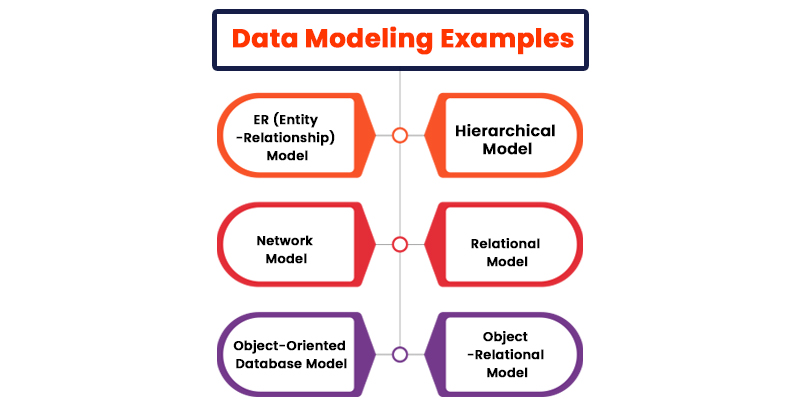
To comprehend a data model, consider it akin to an architect’s blueprint for a building. Just as an architectural plan lays the foundation for all subsequent conceptual models, a data model serves a similar purpose.
These examples of data modelling help to illustrate how data models and the data modelling process emphasise crucial data and its organisation.
1. ER (Entity-Relationship) Model
The ER model serves as a conceptual and systematic way of understanding and representing the data in a database. It revolves around real-world entities and the associations between them. The key elements in this model include entity sets, relationship sets, general attributes, and constraints. Entities refer to real-world objects such as an employee or a product. Attributes are properties with values, while entity sets are groups of entities that share common attributes. Relationships establish the connections between different entities, demonstrating how they are associated with one another. By employing this model, data architects can create a comprehensive depiction of the data structure, making it easier to understand and manipulate the data within the database.
2. Hierarchical Model
The hierarchical data model organises data in a tree-like structure with a single root, from which all other data stems. It operates on a one-to-many relationship between different types of data, allowing for the representation of various real-world relationships. The model’s hierarchy commences with the root node and extends downward in a tree-like fashion. A practical example would be a supermarket where the ‘root’ node represents the supermarket itself, and the ‘child’ nodes would represent departments like Pantry and Packaged Food. This model efficiently illustrates the relationship between the supermarket and its different departments and aisles, showcasing a clear hierarchical structure. However, its inherent one-to-many relationship constraint makes it less flexible for accommodating complex data relationships compared to other models like the relational model.
3. Network Model
The network model is a sophisticated database model that supports intricate data relationships. It enables the establishment of many-to-many connections between various nodes, creating a graph-like structure where ‘child’ nodes can have multiple ‘parent’ nodes. This design promotes a flexible and dynamic approach to data management, allowing for complex data interdependencies to be accurately represented. By using this model, data architects can effectively illustrate intricate relationships between different data points, making it particularly suitable for applications that involve interconnected and interrelated data sets.
4. Relational Model
The relational model, a cornerstone of modern data management, organises data into structured tables with rows and columns. Each column in the table represents a specific attribute associated with the entities being modelled. This model simplifies the identification and management of relationships between various data elements, facilitating efficient data retrieval and manipulation. Its versatility and user-friendly structure make it widely used in various domains, including e-commerce. E-commerce platforms rely on the relational model to efficiently process customer transactions, manage inventory, and streamline overall data management processes.
5. Object-Oriented Database Model
The object-oriented database model defines a database as a collection of objects or reusable software components, each equipped with related methods and features. This model is particularly effective in handling complex data structures and is commonly used in real-time systems like 3D modelling used in architecture and engineering. It provides a powerful framework for managing intricate data relationships and promoting efficient data management in various sophisticated applications.
6. Object-Relational Model
The object-relational model represents a fusion of the object-oriented and relational database models, combining the advanced capabilities of the object-oriented model with the simplicity and efficiency of the relational data model. This integration allows for the management of complex data structures while still leveraging the familiar structure and querying mechanisms of the relational model. The object-relational model is widely used in scenarios where the application demands more sophisticated data management capabilities beyond what the traditional relational model offers.
The data modelling process plays a crucial role in enabling organisations to become more data-driven. It initiates with the cleaning and structuring of data, establishing a foundation for informed decision-making. Let’s explore how data modelling operates at different levels, a fundamental aspect for professionals pursuing Machine Learning Training in Chennai.
Benefits Of Data Modeling
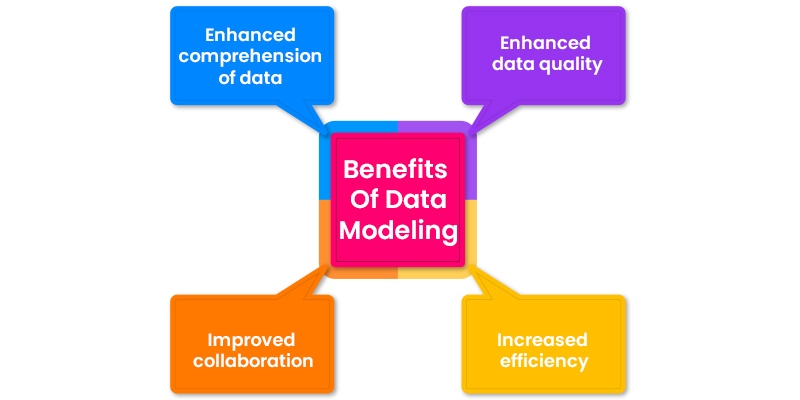
Data modeling holds significant importance in the development of software applications and database systems, offering various benefits:
- Enhanced comprehension of data: By outlining the structure and relationships within the data, data modeling enables stakeholders to gain a deeper understanding, aiding in informed decisions regarding data usage and storage.
- Enhanced data quality: Data modeling aids in the detection of errors and inconsistencies within the data, leading to an overall improvement in data quality and the prevention of potential issues in the future.
- Improved collaboration: The process of data modeling fosters effective communication and collaboration among stakeholders, paving the way for more productive decision-making and favorable outcomes.
- Increased efficiency: Data modelling streamlines the development process by providing a clear and consistent representation of the data, which can be utilised by developers, database administrators, and other stakeholders, ultimately enhancing overall efficiency
Limitations Of Data Modeling
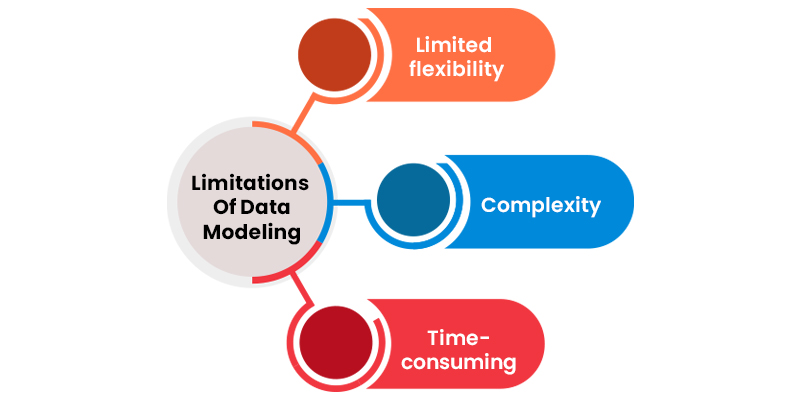
- Limited flexibility: Data models, once established, can pose challenges in adapting to evolving requirements or changes in data structures. This lack of flexibility can result in constraints when modifications or adjustments are necessary. Consequently, organisations may encounter difficulties in accommodating new data elements or accommodating shifting business needs. Furthermore, rigid data models can inhibit the incorporation of novel data sources, leading to potential limitations in data integration and analysis.
- Complexity: Data models, especially those designed for intricate systems or datasets, can become highly intricate and challenging to comprehend. The complexity may stem from the intricate relationships between data entities, intricate data dependencies, and the extensive network of attributes and constraints within the model. Consequently, this complexity can impede effective collaboration among stakeholders, as comprehending and contributing to the data modelling process may require specialised expertise and a deep understanding of the system’s intricacies.
- Time-consuming: Data modelling often involves comprehensive analysis, planning, and meticulous structuring, particularly when dealing with large or complex datasets. This detailed process can consume significant time and resources, leading to potential delays in the development and deployment of systems or applications. Additionally, the iterative nature of data modelling, especially when revisions or updates are required, can further contribute to extended timeframes, potentially impacting project timelines and overall efficiency for professionals seeking Python Training in Chennai.
Evolution Of Data Modeling
Data modelling has undergone significant transformations, mirroring the advancements in technology, the evolution of data management methodologies, and the evolving demands of the business landscape. In the early stages, data modelling primarily entailed manual processes, primarily focusing on the conceptual representation of data. However, contemporary data modelling practices leverage automated tools and techniques that support multiple levels of abstraction, allowing for more intricate and comprehensive data representation.
Several notable trends have emerged in the field of data modelling. The use of specialised data modelling languages and standards, such as Structured Query Language (SQL) and Unified Modeling Language (UML), has become increasingly prevalent. These languages and standards facilitate the systematic organisation and representation of complex data structures, enhancing the precision and efficiency of data management practices.
Moreover, the integration of data modelling with other critical data management processes, including data governance and data quality management, has gained prominence. This integration fosters a holistic approach to data management, ensuring the accuracy, consistency, and reliability of data across the entire organisational spectrum.
The ongoing evolution of data modelling underscores the continued significance of robust data management practices, particularly for professionals enrolled or trying to start from the Data Science Course in Bangalore in the contemporary data-centric business environment. As data continues to serve as a cornerstone of decision-making and strategy formulation, the continual refinement and innovation in data modelling methodologies remain vital for organisations striving to thrive in the dynamic and competitive business landscape.
Types of Data Modeling
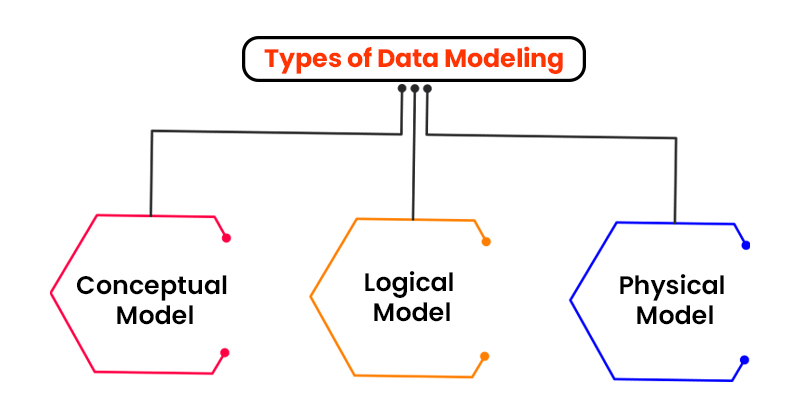
These types of data models play crucial roles in the data modelling process, serving distinct functions at different stages of project planning and analytics. Let’s delve deeper into each type:
1. Conceptual Model
The conceptual model provides a visual representation of fundamental database concepts and their relationships. It focuses on establishing high-level user views of data, emphasising entities, entity attributes, and the relationships between them. It serves as an essential tool for communication between stakeholders, aiding in the understanding of the overall data structure without delving into specific database details.
2. Logical Model
The logical model further refines the structure of data entities and their relationships, serving as a technical blueprint that outlines the rules and structures necessary for a particular project. It aids in the development of a comprehensive understanding of the data flow and architecture, providing a solid foundation for subsequent steps in the data modelling process.
3. Physical Model
The physical model represents the schema or framework dictating the physical storage of data in a database. It involves the detailed specification of data types and attributes, playing a critical role in the actual implementation of the database. The physical model serves as a guide for database designers and administrators, assisting in the actualisation and organisation of the database structure.
The distinction between the logical and physical data models lies in their functions, with the logical model focusing on data representation and the physical model delving into database implementation. The logical model serves as the foundation for the development of the physical model, providing an abstract representation that aids in the generation of the database schema.
Conceptual data modelling finds practical application in various systems, such as employee management systems, simple order management, and hotel reservation systems. These examples highlight its role in effectively communicating and defining the business requirements of the database in a clear and straightforward manner.
Understanding these crucial data modelling types sets the stage for delving into the various techniques employed in the data modelling process.
Data Modeling Techniques
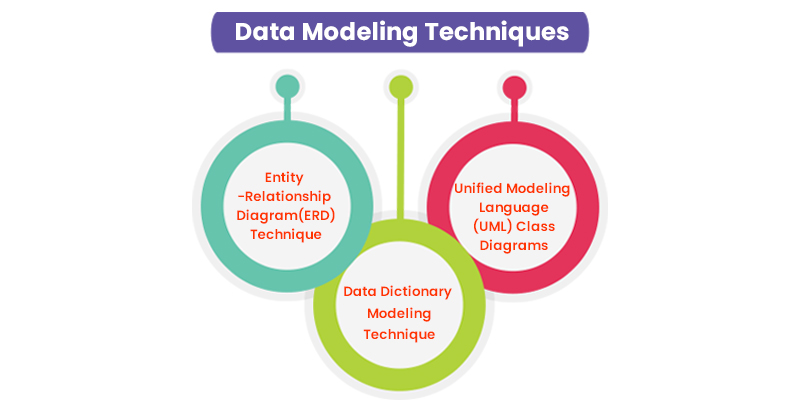
- Entity-Relationship Diagram (ERD) Technique: This technique focuses on modelling and designing relational or traditional databases. It utilises visual representations to illustrate the relationships between various entities within the system, aiding in the development and understanding of database structures.
- Unified Modeling Language (UML) Class Diagrams: The UML is a standardised notation for modelling and designing information systems. UML class diagrams offer a comprehensive way to represent classes, their attributes, methods, and the associations between different objects, providing a holistic view of the data model and its functionalities.
- Data Dictionary Modeling Technique: This technique involves the tabular representation of data assets, serving as a centralised repository for defining and managing data elements, structures, and their relationships within a system. The data dictionary facilitates efficient data management and documentation, ensuring clarity and consistency in data usage and interpretation.
Data Modeling Tools
Data modelling tools play a pivotal role in transforming data into a structured and usable format, making them essential for professionals pursuing a Data Science Course in Chennai. These tools facilitate the creation of a database structure from conceptual diagrams, simplifying the process of data connection and enabling the construction of an optimal data structure tailored to specific requirements.
Importance of Data Modeling
Data modelling serves as a fundamental pillar in data management, governance, and intelligence, offering a multitude of benefits:
- Enhanced data documentation and clarity, leading to improved data quality and performance with minimal errors.
- Compliance with regulatory standards, ensuring adherence to governmental laws and industry regulations.
- Empowerment of employees to make informed data-driven decisions and formulate effective strategies.
- Facilitation of business intelligence through the identification of new opportunities, thus expanding the capabilities of data utilisation and analysis.
